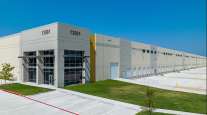GXO Logistics Testing Humanoid Robot at Georgia Facility

[Stay on top of transportation news: Get TTNews in your inbox.]
Warehouse workers could soon face new competition from robots: GXO Logistics Inc. is testing a humanoid model at its facility in Flowery Branch, Ga.
YELLOW AUCTION: XPO bids $870 million for 28 properties
The robot, nicknamed Digit and made by Agility Robotics, a Corvallis, Ore.-based startup, is a little slow grabbing the Spanx apparel and putting it on a conveyor belt, but promises to get better with time.
Agility Robotics has attracted investment from Amazon.com Inc. and is opening a production facility in Salem, Ore., that will eventually have capacity to produce up to 10,000 robots a year, said Damion Shelton, CEO and co-founder, in a telephone interview.
The robot has some limitations. Standing at 5 feet, 9 inches and weighing 140 pounds, Digit can only carry 35 pounds. Its battery pack now lasts about two hours, but that run time is expected to double with the production model, Shelton said.
Taking into account the price of the robot and its life span of about 20,000 hours, the price tag to operate it is about $10 to $12 an hour. With increased production, that cost is expected to fall to $2 or $3 an hour plus overhead for software, Shelton said.
The robot’s human shape allows it to operate in spaces designed for workers. With two feet, the robot can step over objects, and its two arms allow it to reach for things, Shelton said.
Want more news? Listen to today's daily briefing above or go here for more info
Digit isn’t the only humanoid robot out there. Elon Musk has touted Tesla Inc.’s Optimus robot concept. The Atlas robot made by Boston Dynamics, which was acquired by Hyundai Motor Co. in 2021, can do back flips.
Demand for autonomous mobile robots — flat devices that run on wheels and can carry items around warehouses — has exploded because they eliminate the need for workers to walk across cavernous warehouses. Whether humanoid robots become more widely used will depend on how practical and cost-effective the machines are, said Jeff Burnstein, president of the Association for Advancing Automation.
“Just like with every other robotic development, it comes down to the business case,” he said.




